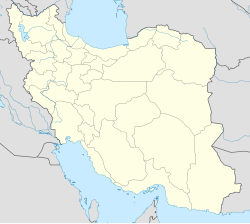Top Qs
Timeline
Chat
Perspective
Takyeh Moaven-ol-Molk
Historic site in Kermanshah, Iran From Wikipedia, the free encyclopedia
Remove ads
Takyeh Moaven-ol-Molk (Persian:تکیه معاون الملک) is a takyeh and historic building in Kermanshah, Iran. It was built during the Qajar era as a Shia mourning site. On 1 December 1975 Takyeh Moaven-ol-Molk was recognized as National monument of Iran. During the Persian Constitutional Revolution, the building suffered significant damage. Later it was renovated.[1]
Remove ads
Description
The building, which lies six metres lower than ground level, has three parts: Hussainiya, Zaeynabiya and Abbasiya. Museum of Anthropology of Kermanshah, and Clothes and Jewelry Museum of Kermanshah are located in Abbasiya.[2]
The Hossainieh walls are covered and adorned with beautiful multi colored tiles, depicting a wild gamut of images, Islamic era Ghazi (warrior), Battle of Karbala and Iranian shahs, Shahnameh kings, European villages, local notables in 19th-century costumes alongside pre-Islamic motifs including Achaemenid dynasty as well as Persepolis.[3]
The architect was Asqar Memarbashi whose name has been written in an inscription on the building’s façade.
Remove ads
Gallery
- Abbasiya
- According to indigenous people's beliefs this heritage is sanctificated by the 8th Shia Imam
- Ancient history of Iran
- Story of Joseph
- Story of Soleiman ibn sor'al-khaza'i
- Dome
References
Wikiwand - on
Seamless Wikipedia browsing. On steroids.
Remove ads













